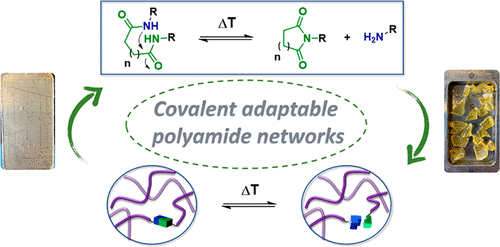当前位置:
X-MOL 学术
›
J. Am. Chem. Soc.
›
论文详情
Our official English website, www.x-mol.net, welcomes your
feedback! (Note: you will need to create a separate account there.)
Reprocessing of Covalent Adaptable Polyamide Networks through Internal Catalysis and Ring-Size Effects
Journal of the American Chemical Society ( IF 14.4 ) Pub Date : 2021-09-15 , DOI: 10.1021/jacs.1c07360 Filip Van Lijsebetten 1 , Yann Spiesschaert 1 , Johan M Winne 2 , Filip E Du Prez 1
Journal of the American Chemical Society ( IF 14.4 ) Pub Date : 2021-09-15 , DOI: 10.1021/jacs.1c07360 Filip Van Lijsebetten 1 , Yann Spiesschaert 1 , Johan M Winne 2 , Filip E Du Prez 1
Affiliation

|
Here, we report the introduction of internally catalyzed amide bonds to obtain covalent adaptable polyamide networks that rely on the dissociation equilibrium between dicarboxamides and imides. While amide bonds are usually considered to be robust and thermally stable, the present study shows that their dynamic character can be activated by a smart choice of available building blocks without the addition of any external catalyst or other additives. Hence, a range of polyamide-based dynamic networks with variable mechanical and viscoelastic properties have been obtained in a systematic study, using a straightforward curing process of dibasic ester and amine compounds. Since the dissociation process involves a cyclic imide formation, the correlation between ring size and the thermomechanical viscosity profile was studied for five- to seven-membered ring intermediates, depending on the chosen dibasic ester monomer. This resulted in a marked temperature response with activation energies in the range of 116–197 kJ mol–1, yielding a sharp transition between elastic and viscous behavior. Moreover, the ease and versatility of this chemistry platform were demonstrated by selecting a variety of amines, resulting in densely cross-linked dynamic networks with Tg values ranging from −20 to 110 °C. With this approach, it is possible to design amorphous polyamide networks with an acute temperature response, allowing for good reprocessability and, simultaneously, high resistance to irreversible deformation at elevated temperatures.
中文翻译:

通过内部催化和环尺寸效应再加工共价适应性聚酰胺网络
在这里,我们报告了内部催化酰胺键的引入,以获得依赖于二甲酰胺和酰亚胺之间解离平衡的共价适应性聚酰胺网络。虽然酰胺键通常被认为是坚固且热稳定的,但本研究表明,无需添加任何外部催化剂或其他添加剂,就可以通过明智地选择可用的构建块来激活它们的动态特性。因此,在系统研究中,使用二元酯和胺化合物的直接固化过程,获得了一系列具有可变机械和粘弹性的聚酰胺基动态网络。由于解离过程涉及环状酰亚胺的形成,根据所选的二元酯单体,研究了五至七元环中间体的环尺寸与热机械粘度曲线之间的相关性。这导致显着的温度响应,活化能范围为 116-197 kJ mol–1,产生弹性和粘性行为之间的急剧转变。此外,该化学平台的易用性和多功能性通过选择各种胺得到证明,从而产生了密集交联的动态网络,T g值范围为 -20 至 110 °C。通过这种方法,可以设计出具有急剧温度响应的无定形聚酰胺网络,从而实现良好的可再加工性,同时在高温下对不可逆变形具有高抵抗力。
更新日期:2021-09-29
中文翻译:

通过内部催化和环尺寸效应再加工共价适应性聚酰胺网络
在这里,我们报告了内部催化酰胺键的引入,以获得依赖于二甲酰胺和酰亚胺之间解离平衡的共价适应性聚酰胺网络。虽然酰胺键通常被认为是坚固且热稳定的,但本研究表明,无需添加任何外部催化剂或其他添加剂,就可以通过明智地选择可用的构建块来激活它们的动态特性。因此,在系统研究中,使用二元酯和胺化合物的直接固化过程,获得了一系列具有可变机械和粘弹性的聚酰胺基动态网络。由于解离过程涉及环状酰亚胺的形成,根据所选的二元酯单体,研究了五至七元环中间体的环尺寸与热机械粘度曲线之间的相关性。这导致显着的温度响应,活化能范围为 116-197 kJ mol–1,产生弹性和粘性行为之间的急剧转变。此外,该化学平台的易用性和多功能性通过选择各种胺得到证明,从而产生了密集交联的动态网络,T g值范围为 -20 至 110 °C。通过这种方法,可以设计出具有急剧温度响应的无定形聚酰胺网络,从而实现良好的可再加工性,同时在高温下对不可逆变形具有高抵抗力。











































 京公网安备 11010802027423号
京公网安备 11010802027423号